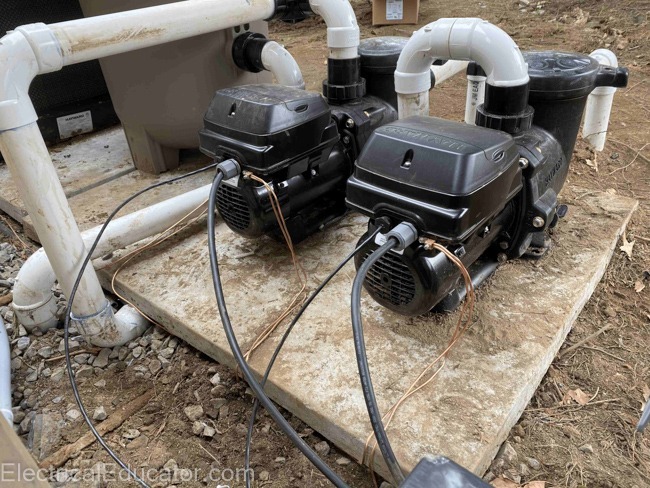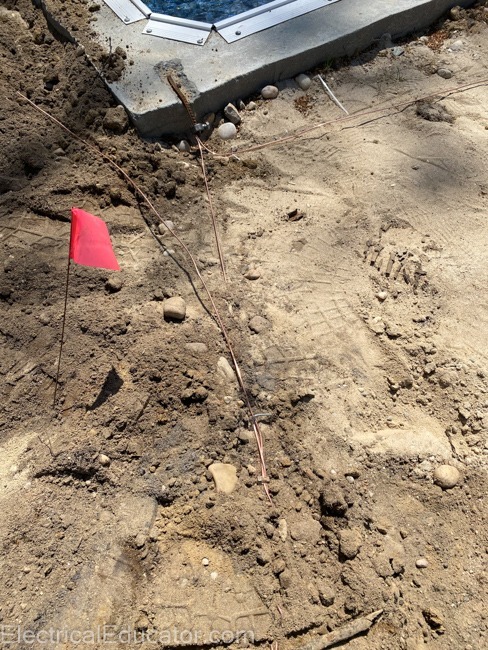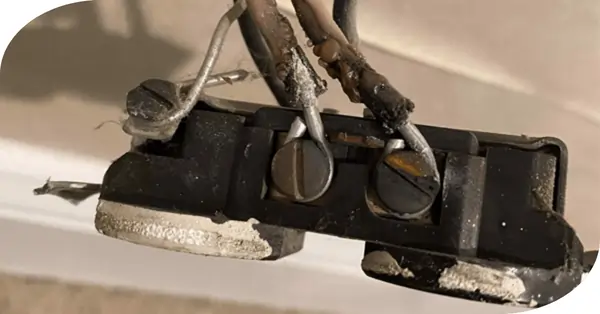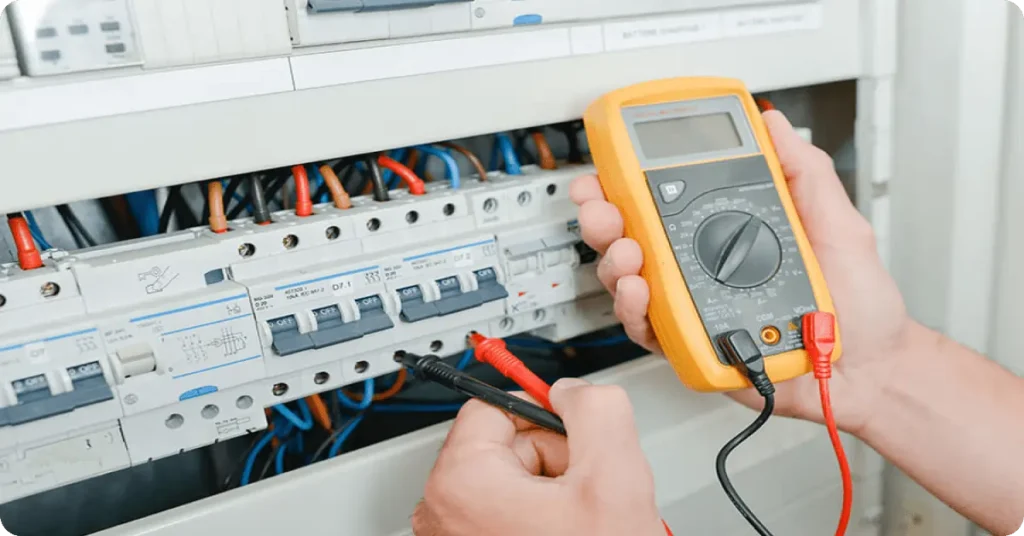
The bonding system of a swimming pool, technically called Equipotential Bonding, exists to reduce any potential shock or electrocution that may result due to an electrical fault in the pool system or any other nearby electrical system. I will try to take out the technicality of how it works and explain the parts that it consists of. In short, a bare conductor connects all pool electrical equipment with the pool shell. It also forms a ring around the pool and ties in to metallic objects near the pool. Too many pool owners are not familiar enough with what pool bonding is and just how important it can be. I’ve recently encountered a few customers that have pools with no bonding and electrical issues underground. I can’t overemphasize how important it is to correct all of these things. For my electricians, engineers, and others with an NEC book we’re at 680.26.

Equipotential Bonding Definition
I’ll start by saying many people call the equipotential bonding of the pool “grounding.” It’s a common confusion but it is incorrect in terms of what we’re trying to accomplish with the pool bonding. Let’s call equipotential bonding EB from here on out. The first sentence in the NEC dealing with EB says: “The equipotential bonding…shall be installed to reduce voltage gradients in the pool area”. We’re trying to prevent shock and electrocution. The way this works directly relates to the physics of voltage. Voltage exists ONLY as the difference between two sources of potential. Any stray voltage wants to get back to the source and ONLY the source, NOT the earth. Stay with me here.
A Deeper Explanation of How Pool Bonding Works
For a better understanding, let’s look at a bird happily sitting on a 7000V high voltage power line, each of the birds feet has the same voltage. Therefore the voltage running through the bird is effectively 0. If this unlucky bird has very long legs and puts one foot on the power line (7000V) and the other foot on the grounded pole (0V), he will assume a path to ground and be electrocuted.
Now lets explain this in terms of a pool and how pool bonding keeps us safe. Firstly, for whatever reason electricity enters the ground. This could be from a failure of an underground service, short in underground wire leaving the home, or a bad grounding (neutral) conductor at a neighbors house. As soon as any fault happens, the electricity is seeking its way back to the source. It’s traveling through the earth and using the earth as a conductor. The next best path to the source may just be your electrical system. In its travels, it may pass your pool or even use your pool or equipment for this!
If your pool is in the way of this path, you guessed it, electricity will be flowing through the pool and surrounding area. Therefore a swimmer or anyone outside the pool touching the earth will be in the path, just like the bird with one foot on the wire and the other on the grounded pole. Now if we have a sufficiently bonded pool, the electricity traveling through the ground assumes the same potential across everything bonded. Therefore our swimmer or person outside the pool touching the earth assumes no potential voltage difference and will stay safe.
What Needs To Be Bonded?
So here’s a nice summarized list right from the NEC of items that need to be bonded. All of these items must be electrically continuous via a #8 SOLID copper conductor. This is by no means meant for any interpretation by anyone as it is a brief summary. Contact a local licensed electrician and reference the NEC for the in depth explanations of the following:
- Concrete Pool Shells via structural reinforcing steel or a copper conductor grid
- Perimeter Surfaces via structural reinforcing steel or a copper bonding ring connecting 4 points of the pool
- Metallic components of the pool: Steel pool shells
- Underwater Lighting: The forming shells of the light, often referred to as the “niche.” Today many new installs do not use these.
- Metal Fittings: These include the ladder cups, handrails, diving board platform, and slide
- Electrical Equipment: Pumps, water heaters, pool covers, heat pumps, etc.
- Fixed Metal Parts 5 Feet or closer to the pool: Room enclosures, gates, piping, awnings, etc.
- Pool water via a water bond fitting. Not required in some instances but why not go the extra mile?
Since writing this article originally, I created a little graphic that helps visualize what needs to happen for a pool to be bonded:

Conclusion
Throughout my career as a master electrician, business owner, and human, I’ve seen quite a bit in the pool bonding space. In our trade publications, we too frequently read articles about tragic deaths associated with pools that have no bonding. It happened not even a quarter mile from our office. If there is anything I can do to help prevent these unnecessary and tragic deaths, here it is. Please pass this on and have a licensed electrician check your pool for proper bonding. Feel free to call any of the folks listed on our National Electrical Registry to help you out. May you have a fantastic and safe swimming season, thank you for reading.
Refer to 680.26 for Equipotential Bonding requirements in the NEC. Consult a local licensed electrician for installation, this is not a DIY.
The same way as an in ground pool! 680.26 in the NEC. You need a licensed electrician to do this properly, no space for DIY here.
Pool bonding entails the mechanical connection of all metal objects related to the pool, in and around the pool area.



Pingback: Pool Chemicals And Routine Maintenance | Electrical Educator
Pingback: Pool Electrician: The Specialty Explained -
Hi Mike,
Excellent article. You truly understand this subject. Many confuse this “bonding” with “grounding.”
I’m a former electrician. I understand the theory and goals. However, I’m wondering whether you might answer a repair question?
If so, here we go. I’m looking at purchasing my dream home that has a pool constructed in the late 1960’s or early 1970’s. I’m well aware of the hazards of improper bonding and am investigating the condition of this pool. Is the bonding system in good shape, or does it even exist in a proper installation?
To the question, if I need to repair or add bonding what does that look like? Clearly, I’ll need to attach to the pool shell. Can that be done by breaking out the deck and attaching my bonding conductor to the rebar that (hopefully) extends out of the pool and under the deck?
As for running the bonding conductor, why not start at the pool equipment, loop the pool, hit the other necessary points, and then return to the equipment? Then, back at the equipment (or elsewhere too), the two conductors could be joined by splitbolts or another listed means.. It seems the 2nd bonding return would add redundancy in case the bonding conductor is damaged in the future..
Thanks for any advice you can offer…
Hi Brad, happy to help! I just sent over an email. If you don’t see it come through leave me another comment here and we’ll figure out how to connect